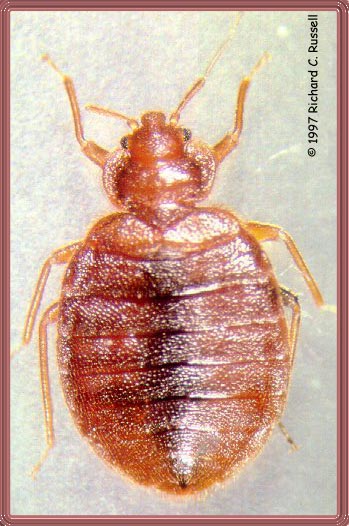
(The Bed Bug)
Unlike most other bugs, the bed bug is wingless. When it has not recently fed the body is paper thin, and almost red brown. So far as is known bed bugs came originally from Asia, but they have now spread to all parts of the world. They were well known in ancient times in the Mediterranean area. As they require a warm, dry climate they did not spread to northern regions until buildings started to be heated, but when this did happen they soon became very abundant. They are now less common and are largely kept under control by modern insecticides.Bedbugs belong to the family of true bugs known as Cimicidae. Members of this family are small, oval, flat, hard-bodied, flightless insects in which the wings are absent or reduced to stubs. When unfed, the common bedbug adult is 1/4 to 3/8 inch in length and brownish in color. After feeding, the body elongates and widens and the color changes to dull red. This apparent change is quite striking and may cause the observer to believe that two different species of insects are present. Bedbug nymphs resemble the adults but are smaller and have a pale yellow coloration after molting. The nymphs undergo five molts, becoming successively larger after each molt. Since some bedbug nymphs may feed more successfully than others, development time may vary greatly even among nymphs from the same generation. For this reason, both adults and nymphs will usually be present throughout the year.
Bedbug eggs are elongate, about 1/32 inch long (see below), white in color, and have a distinct cap at one end. The eggs are laid singly or in clusters and are cemented to wood, fabrics, or other surfaces in places where the bugs hide.
Bed bugs only search for blood donors when they are actually hungry. In the intervals between meals they spend their time in suitable hiding places in the vicinity of the bed. These may be crevices in the timber, joints in the bed, behind the headboard, beneath loose carpeting, behind pictures, behind wallpaper, in plug sockets, light switches, etc. When hungry, bed bugs come out from their retreat and start to search. Their senses are not capable of guiding them to a distant blood donor, but at distances of 5 - 10cm they will be attracted by the body warmth of the victim. Bed bugs can crawl up a wall and can also walk upside down on rough ceilings, but if they are not skilled they often fall down. This is the basis of stories that bed bugs, having observed that their victim had placed the legs of the bed in dishes of water, crawled up the wall and across the ceiling and let themselves fall on to the poor sleeping body. However the bed bug is not as crafty as this.
In the course of about 10 minutes an adult bed bug can suck up to 7 times its own weight in blood. It then retreats to its hiding place, where it digests, mates and lays eggs until it is hungry again. The eggs are laid in the hiding place, where they are attached to the substrate. A female lays 200 - 500 eggs at the rate of 3 or 4 eggs per day, but the actual number depends upon the temperature and other external factors. They do not lay at all at temperatures below 10C. At temperatures above 70° Fahrenheit, egg hatch occurs in 6 to 17 days. Hatching may take up to 28 days at lower temperatures. Development to the adult stage may occur in as little as one or two months, but usually takes longer. A given bedbug individual usually does not feed every night, but at intervals of a few days to a week. Newly-hatched nymphs will feed as soon as possible, then usually feed once between each molt. If left undisturbed, a bedbug can obtain a full blood meal in 3 to 5 minutes. Bedbugs can live for 4 to 12 months without feeding. The bugs will survive longer without a meal at lower temperatures than at higher temperatures.
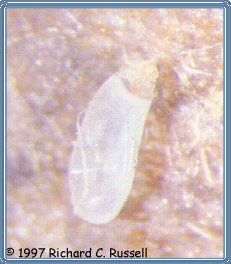
Bed bugs have an incomplete metamorphosis, remember they don't pupate, young bed bugs are like small versions of the adult. They moult 5 times during their development and at each stage they require a blood feed. When fully mature the adult is 4 - 5mm long about the same as a ladybird..!
If the infestation is particularly heavy, then a slight minty smell is apparent when the area is first entered, some people say it smells like old dirty laundry.....depends on the nose I suppose... !
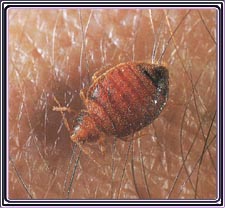
This chap is in the course of having lunch
Bedbugs may be found in many situations, including homes, hotels, poultry houses, around laboratory animals or small caged pets, or near bird and bat nests and roosts. Bedbugs often find their way into the luggage of travelers and may be transported and spread in this manner. If the occupants of a home or apartment infested with bedbugs move out, the bugs may migrate to other nearby dwellings. Similarly, they may occasionally enter homes after a bird or bat control program has eliminated their normal hosts, and are sometimes unknowingly carried into the home from poultry houses. The Fly Bug (Reduvius personatus), an assassin bug, is known to feed upon bedbugs (see below). Presence of this insect in the home may be indicative of bedbug infestations, although this is not always the case since these assassin bugs may enter homes anyway.
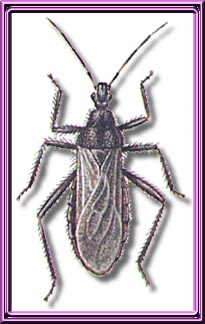
Indications of bed bugs in the initial stages are not obvious (when there are only one or two about), you may notice when you change the bed that there are a few blood spots on the sheets, and you think to yourself that you probably scratched yourself during the night (or the wife punched you on the nose), but this isn't the case as it will be blood from the site on your body where the bed bug sucked your blood. As the infestation increases, you would probably see live insects and at the main harbourage area there would be dark excreta marks (consisting of faeces and partially digested blood). Also in the main area would be cast nymphal skins (see picture below), which shows the skins and excreta marks.
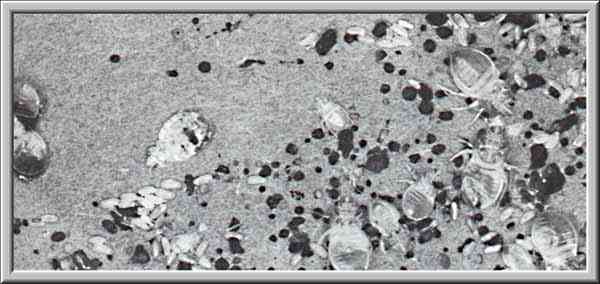
Treatment:
OK.. so how do we treat a bed bug problem...well, you really need to be employing a professional person who knows what they are doing. In turn they need to looking for all potential places where they might be hiding (I have found them in light fittings, light switches, power boxes, inside wooden legs of bunk beds, cracks in plaster, etc) in addition rooms either side of the infestation and also above and below need treating as well to help provide a barrier and to try and contain the problem. By the use of residual sprays and dusting powders and also another visit after about 2 weeks the problem will normally be brought under control.
But...don't forget that bed bugs can be easily transported via luggage, washing, furniture etc., in other words do not move anything out of the infested area without it first being treated. In the case of large infestations such as the wing of a hotel or hospital, then there could be a place for using fumigation. This is a treatment using gas which not only kills the adults but the eggs as well, but there are lots of Health and Safety involved in this sort of operation.
Two of the pictures above are copyright to Richard C. Russell
Sydney University